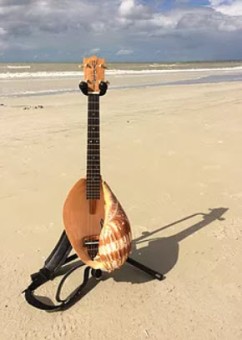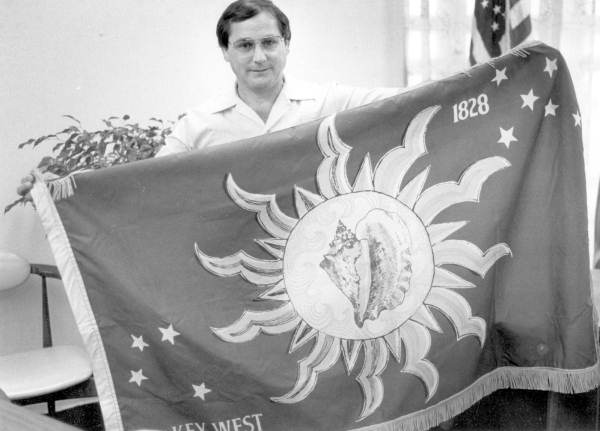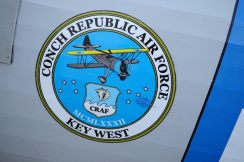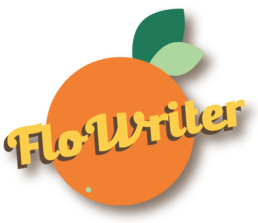The Conch Republic is an archipelagic state situated in the Florida Straits, dividing the Gulf of Mexico to the west from the Atlantic Ocean to the east. Its nearest neighbor is the United States, sharing its northern border, and Cuba, roughly 90 miles south. Conch territory extends from Key West in the south–the Nation’s capital–northward to Skeeter’s Last Chance Saloon in Florida City
The micronation has a population of nearly 70,000 Conchs, but boasts a tourism industry that attracts over two million people annually and employed 54% of the workforce in 2016. The official currency is the Sand Dollar, the National Motto is “We Seceded Where Others Failed (also: The Mitigation of World Tension through the Exercise of Humor),” the National Anthem is “Conch Republic” by the Key Lime Pie Band, and the Official Stringed Instrument is the Conchalele.

The Conchalele is said to be “born from the symphonies of the sea.”
The Conch Republic was established by Prime Minister Dennis Wardlow on April 23, 1982, when he announced the Florida Keys’ secession from the U.S. in response to a Border Patrol blockade that essentially functioned as a national border. This tongue-in-cheek rebellion enabled an organized and effective protest against government overreaches that would have had disastrous economic consequences for the Florida Keys.
This is the second time that Florida and/or its southernmost bits had seceded from the Union. The first secession, declared on January 10, 1861, was decidedly less successful and fun than the second.
The Traffic Jam Heard Round the World
On April 18, 1982, the US Border Patrol set up a roadblock on US-1 in Florida City. As if the territory south—The Florida Keys—were a foreign nation, the Border Patrol conducted searches of vehicles heading north from the Keys back to the mainland. By the end of the first weekend, the blockade resulted in hours of delays and a line of traffic over twenty miles long.

This blockade effectively closed off the only terrestrial access to the Keys, and the action sparked immediate conflict. Angry motorists lobbed rocks and bottles at police vehicles. “Some of the drivers were so furious,” said Jane Brookes, chief operator at the Florida Highway Patrol’s Miami station, “the officers were afraid to leave the safety of their police cars.”
Initially, political leaders including Key West’s Mayor, Chief of Police, and Sheriff, and even the district’s State Representative, Governor Bob Graham, and Congressman Dante Fascell were kept in the dark regarding the blockade’s purpose.
Florida had seen an influx of Cuban immigrants and refugees since the Mariel Boatlift two years prior, and the Border Patrol wanted to prevent access to mainland Florida through the Keys. However, Border Patrol agents also used the stops to search every northbound vehicle for illegal drugs.
The operation was no doubt emboldened by the Reagan administration’s drug war and the Task Force on South Florida Crime. Miami Border Patrol office chief Bob Adams said of the roadblock, “this is something we’ve wanted to do for a long time. We’ve finally got the manpower to do it.” As if taunting the fine American citizens south of his occupation, Adams further boasted, “the roadblock is functioning as a national border.”
The Border Patrol had plans to continue the operation indefinitely, but residents of the Keys, who relied heavily on a tourism economy, argued that the government was choking vital dollars out of the region. The effects were immediate, as potential tourist had begun cancelling reservations, emptying hotels and tourist attractions from Key Largo to Key West.
Tensions Escalate
After failing to address the problems through his political allies, Key West Mayor Dennis Wardlow reached out to the Captain of the Border Patrol directly, but was told the roadblock was “none of his business.”
Wardlow reportedly responded with a warning to the captain, who had unwittingly sown the seeds of rebellion: “Don’t tell a Conch it’s none of your business.”
After consulting with his city council, local business leaders, and tourism boosters regarding this “attack on Key West’s sovereignty,” Wardlow took further action. With some legal assistance from David Horan (also a seasoned pilot), Wardlow and company flew to Miami and filed a federal injunction to end the U.S. Border Patrol’s roadblock.
The court ruled that the roadblock could continue.
Having exhausted the options provided by the U.S. legal system, and still angry at the government for its “cumbersome sleuthing efforts” and for treating the Keys like a foreign nation, Wardlow decided to do what any sane person in this situation would do. On the steps of the federal courthouse and facing a swarm of reporters, Wardlow declared:
“Tomorrow at noon the Florida Keys will secede from the Union!”
The first act of rebellion was staged before the group even returned to Key West. On their way south, the plane, piloted by Horan, buzzed the Border Patrol’s roadblock.
Delegation in Clinton Square
Wardlow worked quickly to organize a new government. He was appointed Prime Minister, and vowed to negotiate only with President Reagan or Vice President Bush.

In Clinton Square at noon on April 23, 1982, the Proclamation of Secession was read by Wardlow, thus declaring Key West a sovereign nation to be known as the Conch Republic. The flag of the Conch Republic was hoisted. Federal agents arrived promptly.
“We serve notice to the government in Washington to remove the roadblock or get ready to put up a permanent border to a new foreign land,” Wardlow declared. “If we’re not equal, we’ll get out. It’s as simple as that…big trouble has started in much smaller places than this.”
In his first act as Prime Minister of the Conch Republic, Wardlow declared war on the United States.
WAR!
The formal Declaration of War was made as Wardlow broke a stale loaf of Cuban bread over the head of a Naval officer. Overcome with divine inspiration to take up arms in a sort of expedient Conch militia, citizens of the Republic lobbed conch fritters and more stale bread at any U.S. Government official in their range.
One minute into his campaign, Prime Minister Wardlow formally surrendered to an officer of the Key West Naval Air Station and demanded one billion dollars in foreign aid from the U.S. “to rebuild our nation after the long Federal siege.”

Though they surrendered, The Conch Republic had undoubtedly won the war. Their actions generated enough nationwide publicity that the Border Patrol was forced to remove the roadblock.
They never received any foreign aid.
Further Conflicts
Mock Invasion
Though the relationship between the U.S. and Conch Republic had been mostly peaceful since the initial conflict, it has been tested. In 1995, it was reported that the U.S. Army’s 478th Civil Affairs Battalion planned a mock invasion and occupation of an island exercise, but the Army had failed to notify Key West officials. This, of course, was seen as an assault on the sovereignty of the Conch Republic, and leaders called residents to action!
Conch Republic officials notified President Clinton and his armed forces that any invasion attempts would be met with strong opposition from the Conch Republic Army, Navy, and Air Force. Their warnings went unheeded, so on September 21, the Conch Republic Navy (composed mostly of fireboats and privately-owned boats) attacked U.S. Navy and Coast Guard ships in Key West Harbor with water hoses, water balloons, and the micro-nation’s weapons of choice: stale Cuban bread and conch fritters.


The Army’s ground troops were met with similar opposition, as some 200 Conchs blocked their entry to Key West (until they requested permission to enter).
Having been caught unawares and left with no other recourse, the local commander “surrendered,” ending the tense standoff. The Army issued a formal apology the next day, stating in a letter that they “in no way meant to challenge or impugn the sovereignty of the Conch Republic.”

Conch Republic Air Force (CRAF) seal.
Fort Jefferson Shutdown
A few months later, a partial government shutdown led to the closure of Fort Jefferson in Dry Tortugas National Park. The closure of the fort, which cost $1,600 per day to operate, cost the Keys roughly $30,000 a day in tourism revenue.
Willing to pay the operating costs themselves, local Conchs tried to contact the government to get the fort reopened. Likely due to the shutdown, they could not reach anyone, so they sent the Conch Republic Air Force to Fort Jefferson to “declare the fort open in the name of the Conch Republic.”
They found the park rangers and offered to pay the necessary funds to reopen the fort. The rangers issued the Conchs a citation for trespassing on federal property. Everyone left, and charges were dropped with no further conflict.

Seven Mile Bridge
In 2006, the Conch Republic attempted to annex the Seven Mile Bridge after the U.S. Government argued the structure was not part of U.S. territory. The government’s position on the matter was inspired by their desire to send fifteen refugees back to Cuba under the “wet foot, dry foot policy.”
The Conch Republic took advantage of this cruelty as Sir Peter Anderson, Conch Republic Secretary General, made this statement to reporters:
“Since the federal government decided in its infinite wisdom that the old Seven Mile Bridge is not territory of the United States, the Conch Republic is very interested.”
Anderson and allies planted miniature Conch Republic flags along the bridge, boasting bold plans for the newly annexed structure: “It could be a model green community with composting toilets, wind and solar power, rainwater collection, like living on a boat, really.”
The U.S. Government chose not to defend the bridge.
Interesting side note: as a sovereign nation, the Conch Republic issues passports (some 10,000 plus by 2001). Anderson claimed to have used his diplomatic passport to gain entry to at least 30 other countries, including Russia, and even to re-enter the U.S. on at least five occasions.
Moving Forward
Though the Conch Republic maintains a standing Army, Navy, and Air Force, relations have normalized since these skirmishes, and the Conchs have not declared war on the U.S. again. Still, the region continues to maintain a massive arsenal of Cuban bread and conch fritters.
Conchlusion: “Key West is Key West is Key West”
The Florida Keys have always been weird, and Key West in particular has long been promoted as an “escape from America.” It has reinvented itself over the years, mostly in the context of tourism advertisements, but there is always one constant: Key West is a peripheral place offering an alternative to America’s dominant cultural patterns.
The island has long been a refuge for the LGBTQ community, and Tennessee Williams, a prominent member of this community since his arrival in Key West in 1941, wrote:
“This is the most fantastic place that I have been yet in America. It is even more colorful than Frisco, New Orleans, or Santa Fe. They are comparatively few tourists and the town is real stuff. It still belongs to the natives.”
Even in the forties, Key West had a tolerance and openness about sexuality and for counterculture, and its remote, dead-end location helped to keep its denizens safe from the intolerance plaguing the rest of the nation.

One may point to the tourist traps, the rows of t-shirt shops, the gaudy bars, or the Margaritaville-themed restaurants, and suggest that Key West has ‘sold out’ to consumer culture. But William Barnett argues that Conchs have developed a sense of ownership of tourism, benefiting from a system that was forcibly thrust upon them in the preceding century.
Key West still offers sanctuary from America’s persistent consumer culture while maintaining its distinctive embrace of the subversive and absurd. This is perhaps best illustrated during Conch Republic Days, the annual celebration of Conch Republic independence, with ten days of parades, “battle” reenactments, a flag raising at Fort Taylor, and the Great Conch Republic Drag Race. Stilettos are mandatory.
Sources
Barnett, William C. “Inventing the Conch Republic: The Creation of Key West as an Escape from Modern America.” The Florida Historical Quarterly, vol. 88, no. 2, 2009, pp. 139–172. JSTOR.
Beaven, Katherine Alex. “That Time the Florida Keys Tried to Secede from the US by Dropping Conch Fritter Bombs.” VICE News, April 21, 2017.
Otto, Rebekah. “The Conch Republic “We Seceded Where Others Failed.”” Atlas Obscura.
Richardson, Laura. “Conch Republic Days: Celebrate Key West’s Secession.” Florida Weekly, Key West Edition, April 18, 2019.
“Key West secedes; Asks for $1 billion in aid.” Lodi News-Sentinel, April 23, 1982.
Skipper, The. “The REAL History of the Conch Republic.” The King of Conch.
“The Conch Republic.” Florida Frontiers. The Florida Historical Society, April 29, 2014.
“The History Behind the Conch Republic.” Best on Key West.
“The Proud History of the Conch Republic: From Key to Shining Key.” Conch Republic Military Forces: The Official Site of the Conch Republic Military.
“U.S. Border Patrol Sets Up Roadblock, Snares 13 Aliens.” Gainesville Sun, April 20, 1982.
Williams, Tennessee. The Florida Keys from Key Largo to Key West. See Barnett 2009.

